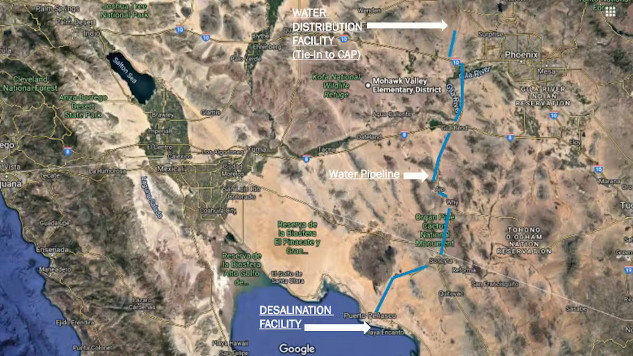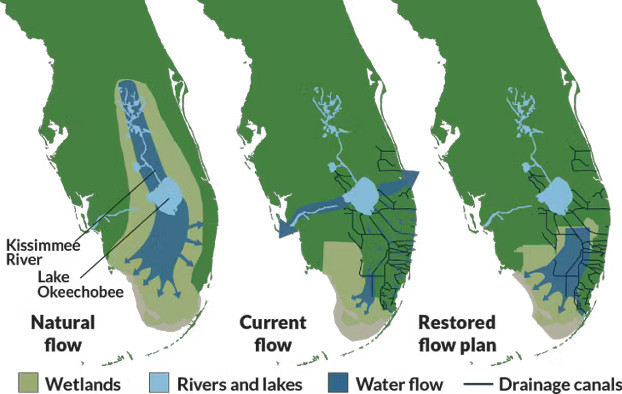
Die geplante Entsalzungsanlage in Mexiko würde Süßwasser über 200 Meilen nach Arizona leiten. Wasserinfrastruktur-Finanzbehörde von Arizona/ENR Southwest, CC BY-ND
Arizona ist eines davon am schnellsten wachsende Bundesstaaten der USA, mit einer Wirtschaft, die Arbeitnehmern und Unternehmen viele Möglichkeiten bietet. Aber es steht vor einer gewaltigen Herausforderung: einer Wasserkrise, die sein Wirtschaftswachstum und seine Vitalität ernsthaft beeinträchtigen könnte.
Ein aktueller Bericht, der projizierte ein etwa 4-prozentiger Mangel an Grundwasservorräten in der Gegend von Phoenix in den nächsten 100 Jahren veranlasste den Staat dazu Neugenehmigung kürzen der grundwasserabhängigen Wohnbebauung in einigen Teilen der Region schnell wachsende Vororte. Darüber hinaus werden die Verhandlungen fortgesetzt schwindende Vorräte aus dem Colorado River, das in der Vergangenheit mehr als ein Drittel des Wassers des Staates lieferte.
Als Teillösung ist die Arizona Water Infrastructure Finance Authority prüft derzeit einen Vorschlag dazu entsalztes Wasser aus Mexiko importieren. Konzipiert von IDE, ein israelisches Unternehmen Mit umfangreicher Erfahrung im Entsalzungssektor erfordert dieses Mega-Ingenieurprojekt den Bau einer Anlage in Mexiko und die Leitung des Wassers über etwa 200 Meilen und mehr als 2,000 Fuß bergauf nach Arizona.
Letztendlich ist das Projekt geplant kostete mehr als 5 Milliarden US-Dollar und Bereitstellung von Frischwasser zu fast dem Zehnfachen der Kosten für das Wasser, das Arizona derzeit aus dem Colorado River bezieht, ohne langfristige Energie- und Wartungskosten.
Ist das eine sinnvolle Investition? Das ist schwer zu sagen, da die Details noch offen sind. Es ist auch unklar, wie der Vorschlag zu Arizonas Plänen für Investitionen in seine Wasserversorgung passt – denn im Gegensatz zu einigen Bundesstaaten gibt es in Arizona keinen staatlichen Wasserplan.
Als Forscher, die sich auf Wasser konzentrieren Rechtswesen, Datenschutzrichtlinien und ManagementWir empfehlen, dass technische Projekte wie dieses als Teil eines umfassenderen Wassermanagement-Portfolios betrachtet werden, das ganzheitlich auf Ungleichgewichte bei Angebot und Nachfrage reagiert. Und solche Entscheidungen sollten bekannte und potenzielle Folgen und Kosten in der Zukunft berücksichtigen. Israels Ansatz zur Entsalzung bietet Erkenntnisse, die Arizona gut berücksichtigen sollte. Eine 20-jährige Dürre im Einzugsgebiet des Colorado River wirft kritische Fragen für die Wasserzukunft Arizonas auf.
Gefährdete Gebiete und Gewässer
Auf der ganzen Welt haben Wasserbauprojekte große ökologische Schäden verursacht, für deren Behebung die Regierungen jetzt viel Geld ausgeben. Entwässerung und Glättung die Florida Everglades Ein bekanntes Beispiel ist die Katastrophe in den 1950er und 60er Jahren, die die Wasserqualität und die Tierwelt erheblich beeinträchtigte.

Staatliche und bundesstaatliche Behörden geben Milliarden von Dollar für die Wiederherstellung der Everglades aus und machen damit Wasserkontrollprojekte von 1948 bis 1963 rückgängig, die diese riesigen Feuchtgebiete kanalisiert und trockengelegt haben. US Army Corps of Engineers/Florida Museum
Israels Hula-Feuchtgebiete ist ein anderer. In den 1950er Jahren betrachteten israelische Wassermanager die Feuchtgebiete nördlich des Sees Genezareth als einen von Malaria befallenen Sumpf, dessen Entwässerung die Mücken ausrotten und das Gebiet für die Landwirtschaft öffnen würde. Das Projekt war ein völliges Scheitern Dies führte zu Staubstürmen, Landverödung und dem Verlust vieler einzigartiger Tiere und Pflanzen.
Arizona befindet sich derzeit aufgrund einer Kombination aus Wassermanagementlücken und klimatischen Veränderungen in einer Krise. Grundwasserentnahmen, die in weiten Teilen des ländlichen Arizonas weiterhin unreguliert sind, umfassen unkontrolliertes Vorbeipumpen ausländische landwirtschaftliche Interessen die ihre Ernte ins Ausland verschiffen. Darüber hinaus ist der Colorado River jetzt in seinem 23. Jahr der Dürre, Arizona ist gezwungen, seine Abhängigkeit vom Fluss zu verringern und Suchen Sie nach neuen Wasserquellen.
Die von Arizona in Betracht gezogene Entsalzungsanlage soll in Puerto Peñasco gebaut werden, einem mexikanischen Ferienort am nördlichen Rand des Landes Golf von Kalifornien, auch bekannt als das Meer von Cortez. Stark salzhaltige Sole, die beim Entsalzungsprozess übrig bleibt, würde in den Golf gelangen.
Da diese Bucht eine langgestreckte, buchtenartige Geographie aufweist, könnte sich Salz in ihrem oberen Bereich ansammeln und gefährdete Wasserarten wie z. B. schädigen der Totoaba-Fisch und der Vaquita-Schweinswal, das am stärksten gefährdete Meeressäugetier der Welt.
Die Pipeline, die entsalztes Wasser nach Arizona transportieren würde, würde durchqueren Orgelpfeifenkaktus National Monument, ein fragiles Wüstenökosystem und UNESCO-Biosphärenreservat, das bereits beschädigt wurde Bau der Grenzmauer zwischen den USA und Mexiko. Um die Anlage zu betreiben, schlägt IDE den Bau eines Kraftwerks in Arizona und die Verlegung von Übertragungsleitungen durch dieselbe fragile Wüste vor.
Keine einheitliche Lösung
Israel hat sich an die Wasserknappheit angepasst und aus seinem katastrophalen Unterfangen in den Hula-Feuchtgebieten gelernt. Heute hat das Land eine Masterplan für den Wassersektor das regelmäßig aktualisiert wird und auf Wasserrecycling und -wiederverwendung sowie einem umfangreichen Entsalzungsprogramm basiert.
Israel hat außerdem umfangreiche Wasserspar-, Effizienz- und Recyclingprogramme sowie eine umfassende wirtschaftliche Überprüfung der Entsalzung umgesetzt. Zusammen decken diese Quellen nun den größten Teil des Wasserbedarfs des Landes, und Israel ist in beiden Bereichen führend Wassertechnologie und politische Innovation.
Die Wasserrechte und -gesetze in Arizona unterscheiden sich von denen in Israel, und Arizona ist nicht so nah am Meerwasser. Nichtsdestotrotz ist Israels Ansatz aus unserer Sicht relevant, da Arizona daran arbeitet, die Lücke zwischen Wassernachfrage und -angebot zu schließen.
Schritte, die Arizona jetzt unternehmen kann
Unserer Ansicht nach täte Arizona gut daran, dem Beispiel Israels zu folgen. Ein logischer erster Schritt wäre die Erstellung von Naturschutzprogrammen in einigen Teilen von Arizona erforderlich, landesweit obligatorisch.
Verwendung in der Bewässerungslandwirtschaft mehr als 70 % der Wasserversorgung Arizonasund die meisten bewässerten Flächen des Staates werden genutzt Hochwasserbewässerung – Wasser auf Felder pumpen oder bringen und über den Boden fließen lassen. Stärkere Nutzung von Tröpfchenbewässerung, das den Pflanzenwurzeln über Kunststoffrohre Wasser zuführt, und andere wassersparende Techniken und Technologien würden den Wasserverbrauch in der Landwirtschaft reduzieren.
Haushalte in Arizona, die manchmal bis zu 70 % des Wassers in Wohngebieten verbrauchen Rasen- und Landschaftsbau, spielen auch eine Erhaltungsrolle. Und der Grundwasserverbrauch des Bergbausektors ist derzeit gering weitgehend von staatlichen Regelungen und Auszahlungsbeschränkungen befreit.
Ein proaktiver und ganzheitlicher Wassermanagementansatz sollte für alle Wirtschaftszweige, einschließlich der Industrie, gelten. Arizona sollte auch weiterhin Programme für Landwirtschaft, Kommunen und Industrie ausbauen Wiederverwendung von Abwasser.
Entsalzung muss nicht vom Tisch sein. Aber wie in Israel sehen wir es als Teil davon eine vielfältige und integrierte Lösungsreihe. Durch die Untersuchung der wirtschaftlichen, technischen und ökologischen Machbarkeit alternativer Lösungen könnte Arizona ein Wasserportfolio entwickeln, das weitaus wahrscheinlicher wäre als massive Investitionen in die Meerwasserentsalzung, um die nachhaltige und sichere Wasserzukunft zu erreichen, die der Staat anstrebt.![]()
Über den Autor
Gabriel Eckstein, Professor für Recht, Texas A & M Universität; Clive Lipchin, Außerordentlicher Professor für Umweltstudien, Universität Tel Aviv und Sharon B. Megdal, Professor für Umweltwissenschaften und Direktor des Water Resources Research Center, University of Arizona
Dieser Artikel wird erneut veröffentlicht Das Gespräch unter einer Creative Commons-Lizenz. Lies das Original Artikel.
Bücher zum Thema Umwelt aus der Amazon-Bestsellerliste
"Stille Quelle"
von Rachel Carson
Dieses klassische Buch ist ein Meilenstein in der Geschichte des Umweltschutzes und lenkt die Aufmerksamkeit auf die schädlichen Auswirkungen von Pestiziden und ihre Auswirkungen auf die Natur. Carsons Arbeit hat dazu beigetragen, die moderne Umweltbewegung zu inspirieren, und ist bis heute relevant, da wir uns weiterhin mit den Herausforderungen der Umweltgesundheit auseinandersetzen.
Klicken Sie für weitere Informationen oder zum Bestellen
"Die unbewohnbare Erde: Leben nach der Erwärmung"
von David Wallace-Wells
In diesem Buch warnt David Wallace-Wells eindringlich vor den verheerenden Auswirkungen des Klimawandels und der dringenden Notwendigkeit, diese globale Krise anzugehen. Das Buch stützt sich auf wissenschaftliche Forschung und Beispiele aus der Praxis, um einen ernüchternden Blick auf die Zukunft zu werfen, der wir gegenüberstehen, wenn wir nicht handeln.
Klicken Sie für weitere Informationen oder zum Bestellen
„Das verborgene Leben der Bäume: Was sie fühlen, wie sie kommunizieren? Entdeckungen aus einer geheimen Welt“
von Peter Wohlleben
In diesem Buch erforscht Peter Wohlleben die faszinierende Welt der Bäume und ihre Rolle im Ökosystem. Das Buch stützt sich auf wissenschaftliche Forschung und Wohllebens eigene Erfahrungen als Förster, um Einblicke in die komplexen Wechselwirkungen zwischen Bäumen und der Natur zu geben.
Klicken Sie für weitere Informationen oder zum Bestellen
"Unser Haus brennt: Szenen einer Familie und eines Planeten in der Krise"
von Greta Thunberg, Svante Thunberg und Malena Ernman
In diesem Buch bieten die Klimaaktivistin Greta Thunberg und ihre Familie einen persönlichen Bericht über ihre Reise, um das Bewusstsein für die dringende Notwendigkeit zu schärfen, den Klimawandel anzugehen. Das Buch bietet eine kraftvolle und bewegende Darstellung der Herausforderungen, vor denen wir stehen, und des Handlungsbedarfs.
Klicken Sie für weitere Informationen oder zum Bestellen
"Das sechste Aussterben: Eine unnatürliche Geschichte"
von Elizabeth Kolbert
In diesem Buch untersucht Elizabeth Kolbert das anhaltende Massensterben von Arten, das durch menschliche Aktivitäten verursacht wird, und stützt sich dabei auf wissenschaftliche Forschung und Beispiele aus der Praxis, um einen ernüchternden Blick auf die Auswirkungen menschlicher Aktivitäten auf die natürliche Welt zu werfen. Das Buch bietet einen überzeugenden Aufruf zum Handeln, um die Vielfalt des Lebens auf der Erde zu schützen.





















